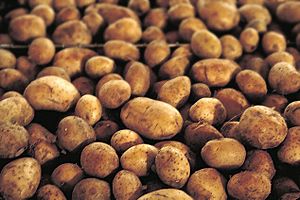Potato Control Law facts for kids
 |
|
| Other short titles | Agricultural Adjustment Act Amendment of 1935 |
|---|---|
| Long title | An Act to amend the Agricultural Adjustment Act, and for other purposes. |
| Nicknames | Potato Control Act of 1935 |
| Enacted by | the 74th United States Congress |
| Effective | August 24, 1935 |
| Citations | |
| Public law | 74-320 |
| Statutes at Large | 49 Stat. 774 aka 49 Stat. 782 |
| Codification | |
| Titles amended | 7 U.S.C.: Agriculture |
| U.S.C. sections created | 7 U.S.C. ch. 29 §§ 801-833 |
| Legislative history | |
|
|
The Potato Control Law was a special rule made in 1935 to help farmers during a tough time called the Great Depression. This was when many people lost their jobs and money. The idea for this law started with U.S. President Herbert Hoover and was later signed into law by President Franklin D. Roosevelt on August 24, 1935.
Contents
Why the Potato Control Law Was Created
This law was put in place by the Agricultural Adjustment Administration (AAA). Its main goal was to help about 30,000 farmers who grew potatoes for a living. These farmers were worried that too many potatoes would be grown, making prices drop very low. This could happen if other farmers, whose lands were not being used for other crops because of different AAA rules, decided to grow potatoes instead.
How the Law Controlled Potatoes
The Potato Control Law tried to manage the potato market in a few ways:
- It limited how many potatoes could be sent out of the country.
- It said that potatoes should be used to help people who needed food.
- It made sure that potatoes could only be bought or sold if they were in special containers approved by the government. These containers had to have official stamps.
Rules and Penalties
If someone bought or sold potatoes without the right stamps or containers, they could face serious consequences. For a first mistake, they might have to pay a large fine. If they did it again, the fine would be even bigger, and they could face time in jail. Farmers and sellers also had to pay a tax for each bushel of potatoes, or get special tax-free stamps from the government.
Protests Against the Law
Many people did not like the Potato Control Law because they felt it was unfair and that the government was getting too involved in their businesses. For example, in 1935, citizens in West Amwell Township, New Jersey, signed a statement saying they would not follow the law. They believed they should be free to grow and sell their potatoes as they wished.
Helping People in Need
Even though the law was controversial, it also included a helpful part. It created the Federal Surplus Relief Corporation. This group was designed to give extra food, like potatoes, to places that help people who are hungry or homeless. Today, a program called The Emergency Food Assistance Program (TEFAP) continues this important work, providing food to soup kitchens and shelters.
Why the Law Ended
The Potato Control Law was very new because it showed the government getting deeply involved in farming and the economy. Because of this, it was seen as one of the most debated laws of the New Deal era. In 1936, the United States Supreme Court decided that the law was against the rules of the U.S. Constitution, and so it was stopped.
Ley de Ajuste Agrario nl:Agricultural Adjustment Administration ja:農業調整法 pt:Agricultural Adjustment Administration


